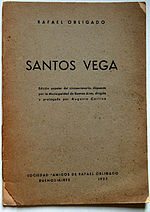Santos Vega

Santos Vega was a mythical Argentine gaucho, and invincible[citation needed] payador (a kind of minstrel that competed in singing competitions resembling dialectic discussions), who was only defeated by the Devil himself,[citation needed] disguised as the payador Juan sin Ropa ("John Clothless").
The myth states he is buried near San Clemente del Tuyú.
Argentina's President Bartolomé Mitre was the first to compose a poem based on the legend. Afterwards, Hilario Ascasubi wrote "Santos Vega o los Mellizos de la Flor", a long poem in which the minstrel narrates the events. Soon after, Eduardo Gutiérrez published the "Story of Santos Vega and his friend Carmona prosecuted by justice" as a feuilleton. Finally, Rafael Obligado, inspired on Gutiérrez's work, composed his best poem "Santos Vega", one of the top works of Argentine literature.
A 1936 film Santos Vega was released.
Rafael Obligado
[edit]Rafael Obligado's poem is romanticist, because it emphasizes nature, twilight, nationalism, and the four elements. It is divided in four cantos: The Minstrel's Soul, The Minstrel's Wife, The Minstrel's Hymn and The Minstrel's Death. They don't follow a chronological order since the first two feature the "ghost" that inhabits the pampas, the fourth tells his last duel with the Devil; and the third one was a later addition in which Santos Vega (alive) interrupts a match of Pato and calls the gauchos to join the May Revolution.
